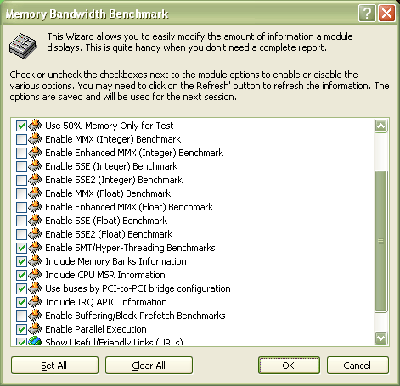Mushkin & Adata: 2 for the Fast-Timings Lane
by Wesley Fink on September 1, 2003 11:18 PM EST- Posted in
- Memory
Test Design
For tests of the Mushkin Level II PC3500 and Adata PC450, we are continuing the memory test suite established in our article, “Search for the Memory Holy Grail — Part 2”.
1) SiSoft Sandra Max3 UNBuffered Memory Test
The Sandra UNBuffered Memory Test, as we demonstrated in Part 1, turns off Memory Buffering schemes in an attempt to better measure raw memory bandwidth. As a result, it also correlates well with bandwidths reported with Memtest86, an industry-standard memory testing tool.The idea of the UNBuffered Memory Benchmark is very simple — you merely turn-off all memory buffering techniques. Sandra makes this very easy to do. Select “Memory Benchmark”, right-click “Module Options”, and uncheck the 9 boxes that have to do with buffering as you see here.
Click image to view a larger picture.
2) SiSoft Sandra Max3 Standard Memory Test
The UNBuffered Memory Benchmarks are quite different form what you may be accustomed to seeing in memory testing with SiSoft Sandra. For reference, we are again including the Sandra Max3 standard Memory Test, sometimes called the Buffered Memory Test.
3) Super PI
Pure number crunching benchmarks are very useful for measuring system bandwidth. Some of the more popular number-crunchers are the MPEG/DIVX encoding tests, such as we used in our standard motherboard testing, and Super PI. MPEG/DIVX tests are very useful for a single motherboard benchmark and in cross-platform testing (Athlon vs. Pentuium4, for example). However, they are often very sensitive to the test environment or system configuration. In addition, it can be difficult to use reliably in a testing environment of a large number of conditions with the same test, such as we will be doing here in our memory testing. Super PI, on the other hand, is very simple to use and has been shown to be less sensitive to the operating system environment. In other words, we don’t have to reinstall the operating system on a clean hard drive each time we run a benchmark just to get reliable numbers.Super PI for Windows 1.1 is a freeware program developed by the Super Computer Consortium at the University of Tokyo. The concept of Super PI is very simple. It calculates the value of pi to “x” number of places, and reports the time this calculation requires. We chose to use 2 million places in our tests. Super PI is measuring total system bandwidth, and memory is only part of that bandwidth, since the CPU has a very significant impact on results. We therefore would expect to see smaller changes in Super PI relative to larger changes in memory-only benchmark tests like Sandra.
4) Quake3 Demo FOUR.dm_66
Quake 3 Demo FOUR is one of our standard game benchmarks. You will likely be surprised how sensitive Quake3 can actually be in testing wide variations in Memory Speed. We run the benchmark 3 times, check for score consistency, repeat if we see any wide variation in individual scores, and average the 3 scores for the reported Frames Per Second (FPS) value.
5) Unreal Tournament 2003 Demo
We ran UT2003 as a further test to check correlation of our benchmarks. We are reporting UT2003 results from our Mushkin and Adata tests. UT2003, as shown in our past memory testing, mirrors relative results from Quake3.











17 Comments
View All Comments
Wesley Fink - Tuesday, September 2, 2003 - link
MUSHKIN PC3500 LEVEL II AT FSB1000, 5:4 (DDR400, 2-2-2-5)We ran 1000FSB (500) at 5:4 with Mushkin PC3500 Level II at CAS 2-2-2-5. The testbed and ALL hardware and settings were the same as this review except for FSB/Ratio. Results are:
Sandra UNBuffered - 2964/2959 or avg. 2962
Sandra Buffered (Standard) ? 5470/5468 or avg. 5469
Quake 3 ? 393.7fps
UT2003 ? Flyby: 241.84
Botmatch: 87.66
SuperPI (2M places) ? 105s
Write these numbers down and compare them to DDR400 on page 8&9 and DDR500 in Part 2 Page 14 (500FSB/DDR500) charts. You will see that 5:4 2-2-2-5 is very close to the performance of the DDR500.
Anonymous User - Tuesday, September 2, 2003 - link
Oops... I have to take my last comment back. :(I have read through the whole article, and I dont see 250 FSB 1:1 3-4-4-8 vs 5:4 2-2-2-5 (200fsb vs. 250fsb ram speed) If they arent both tested together at the same CPU speed and FSB, only with the mem speed and timings change, its not perfect... But still a good review anyhow. :D
Retrospooty
Anonymous User - Tuesday, September 2, 2003 - link
Awesome review Wes,You took user feedback from the last review and tested your ram in a way NO OTHER REVIEWER HAS DONE SO FAR !!!! The right way.
Well done my friend, well done.
Retrospooty
Anonymous User - Tuesday, September 2, 2003 - link
Black is cool!the mushkin PC3500 Level II is the perfect combination with a IC7 Max3.
Anonymous User - Tuesday, September 2, 2003 - link
Given your propensity (and abuse by others) for OCZ, why did'nt you include OCZ platinum 3500 which is their ultra low latency RAM in this test. I have 2x256Mb OCZ platinum PC3200 (PC3500 wasnt and still isn't available in Australia when I built my system) in an ABIT IC7-G with 2.6C CPU. I get 2-2-2-5 to 190Mhz, 2-2-3-5 to 218 MHz and up to 230MHz on looser settings. I am moderately satisfied with this but I was offered CORSAIR XMS 3200 at time of purchase and, given your comments about Rev 1.1, I perhaps regret the path I took!wicktron - Tuesday, September 2, 2003 - link
I think you need to change the titles of the graphs on this page: http://www.anandtech.com/memory/showdoc.html?i=185...to DDR400 rather than DDR500.
wicktron - Tuesday, September 2, 2003 - link
Great review Wes.